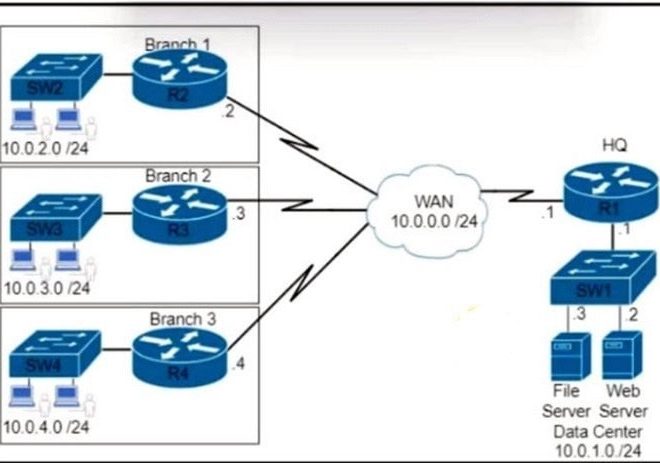[2017 PDF free download] Latest Cisco 200-125 Dumps Exam Practice Questions, Best 200-125 Exam PDF Free Download At Lead4pass
Question No : 1
A router has two Fast Ethernet interfaces and needs to connect to four VLANs in the local network. How can you accomplish this task, using the fewest physical interfaces and without decreasing http://www.leads4pass.com/200-125.html network performance?
A. Use a hub to connect the four VLANS with a Fast Ethernet interface on the router.
B. Add a second router to handle the VLAN traffic.
C. Add two more Fast Ethernet interfaces.
D. Implement a router-on-a-stick configuration.
Answer: D
Explanation:
A router on a stick allows you to use sub-interfaces to create multiple logical networks on a single physical interface.
Question No : 2
Refer to the graphic.

Host A is communicating with the server. What will be the source MAC address of the frames received by Host A from the server?
A. the MAC address of router interface e0
B. the MAC address of router interface e1
C. the MAC address of the server network interface
D. the MAC address of host A
Answer: A
Explanation:
Whereas switches can only examine and forward 200-125 packets based on the contents of the MAC header, routers can look further into the packet to discover the network for which a packet is destined. Routers make forwarding decisions based on the packet’s networklayer header (such as an IPX header or IP header). These network-layer headers contain source and destination network addresses. Local devices address packets to the router’s MAC address in the MAC header. After receiving the packets, the router must perform the following steps:
1. Check the incoming packet for corruption, and remove the MAC header. The router checks the packet for MAC-layer errors. The router then strips off the MAC header and examines the network-layer header to determine what to do with the packet.
2. Examine the age of the packet. The router must ensure that the packet has not come too far to be forwarded. For example, IPX headers contain a hop count. By default, 15 hops is the maximum number of hops (or routers) that a packet can cross. If a packet has a hop count of 15, the router discards the packet. IP headers contain a Time to Live (TTL) value. Unlike the IPX hop count, which increments as the packet is forwarded through each router, the IP TTL value decrements as the IP packet is forwarded through each router. If an IP packet has a TTL value of 1, the router discards the packet. A router cannot decrement the TTL value to 1 and then forward the packet.
3. Determine the route to the destination. Routers maintain a routing table that lists available networks, the direction to the desired network (the outgoing interface number), and the distance to those networks. After determining which direction to forward the packet, the router must build a new header. (If you want to read the IP routing tables on a Windows 95/98 workstation, type ROUTE PRINT in the DOS box.)
4. Build the new MAC header and forward the packet. Finally, the router builds a new MAC header for the packet. The MAC header includes the router’s MAC address and the 200-125 final destination’s MAC address or the MAC address of the next router in the path.
Question No : 3
Refer to the exhibit:
 \
\
What will Router1 do when it receives the data frame shown? (Choose three.)
A. Router1 will strip off the source MAC address and replace it with the MAC address 0000.0c36.6965.
B. Router1 will strip off the source IP address and replace it with the IP address 192.168.40.1.
C. Router1 will strip off the destination MAC address and replace it with the MAC address 0000.0c07.4320.
D. Router1 will strip off the destination IP address and replace it with the IP address of 192.168.40.1.
E. Router1 will forward the data packet out interface FastEthernet0/1.
F. Router1 will forward the data packet out interface FastEthernet0/2.
Answer: A,C,F
Explanation:
Remember, the source and destination MAC changes as each router hop along with the TTL being decremented but the source and destination IP address remain the same from source to 200-125 destination.
Question No : 4
Which three statements accurately describe Layer 2 Ethernet switches? (Choose three.)
A. Spanning Tree Protocol allows switches to automatically share VLAN information.
B. Establishing VLANs increases the number of broadcast domains.
C. Switches that are configured with VLANs make forwarding decisions based on both Layer 2 and Layer 3 address information.
D. Microsegmentation decreases the number of collisions on the network.
E. In a properly functioning network with redundant switched paths, each switched segment will contain one root bridge with all its ports in the forwarding state. All other switches in that broadcast domain will have only one root port.
F. If a switch receives a frame for an unknown destination, it uses ARP to resolve the address.
Answer: B,D,E
Explanation:
Microsegmentation is a network design (functionality) where each workstation or device on a network gets its own dedicated segment (collision domain) to the http://www.leads4pass.com/200-125.html switch. Each network device gets the full bandwidth of the segment and does not have to share the segment with other devices. Microsegmentation reduces and can even eliminate collisions because each segment is its own collision domain ->.
Note: Microsegmentation decreases the number of collisions but it increases the number of collision domains.
Click here to download free pdf files: https://drive.google.com/open?id=0B7LFs7RuvDV4X2VtU1ZHYkxpR2c
Watch the video to learn more:


![[New May 2023] Updated 300-425 Dumps For 300-425 ENWLSD Exam](https://www.ciscoexampdf.com/wp-content/uploads/2023/05/Updated-300-425-Dumps.jpg)